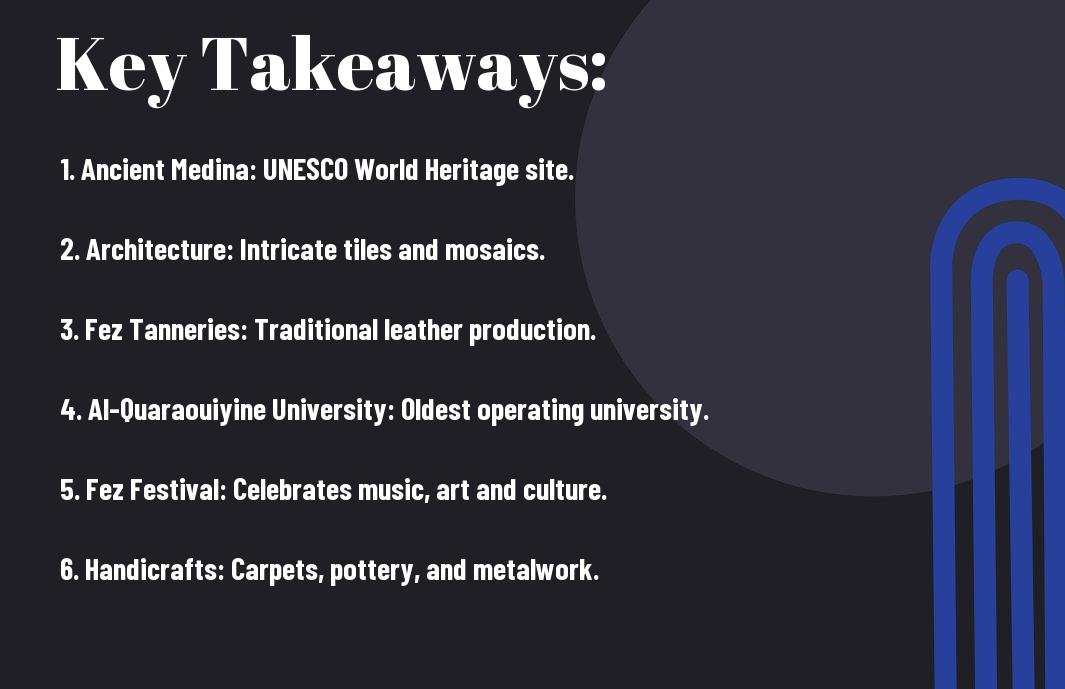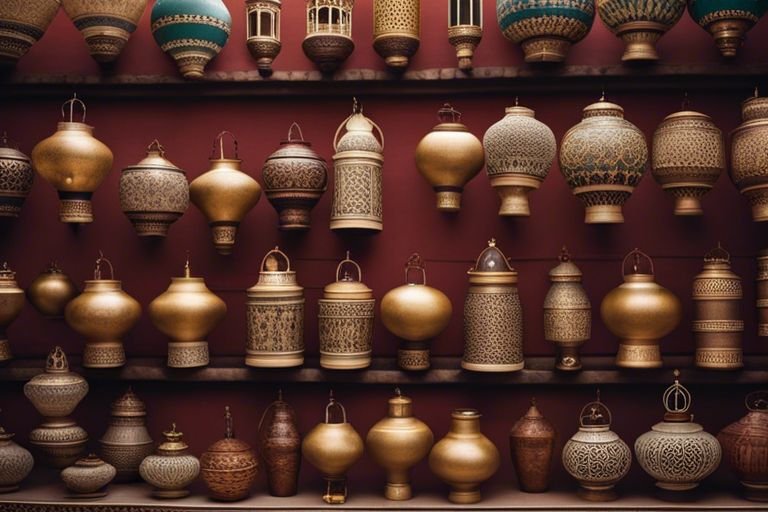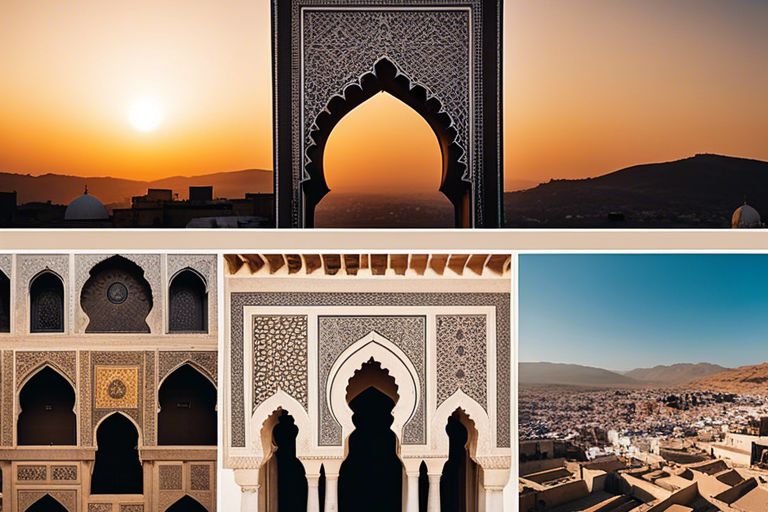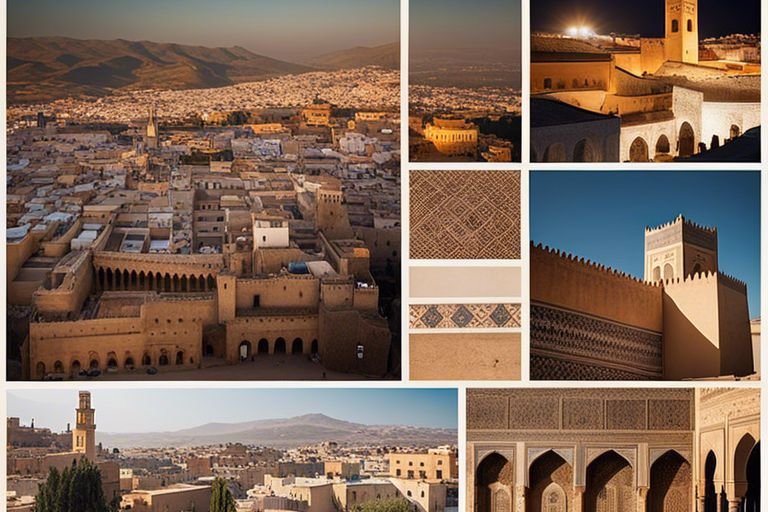Over centuries, Fez has cemented its reputation as one of Morocco’s most culturally rich and historically significant cities. As one of the country’s oldest and most renowned imperial cities, Fez boasts many attractions that continue to attract visitors worldwide. From its well-preserved medieval architecture and iconic landmarks to its vibrant souks and traditional artisan workshops, Fez offers a unique glimpse into Morocco’s past and present.
Advertisement
Should visitors find themselves torn between visiting Fez or Marrakesh, a common dilemma for many tourists, it’s essential to consider the distinct charms of each city. Both destinations offer a wealth of experiences, but for those seeking a deeper dive into Morocco’s heritage and authenticity, Fez undoubtedly stands out. To explore this topic further, you can read discussions on whether we should go to Fes or Marrakesh if we only have time to see one as a tourist.
Key Takeaways:
- Fez is famous for being one of the oldest medieval cities in the world, with a well-preserved old town or Medina dating back to the 9th century.
- Fez is known for its traditional Moroccan architecture, particularly the distinctive geometric tilework and intricate wood carvings in many buildings.
- Fez is renowned for its ancient tanneries, where leather has been produced using the same methods for centuries, offering visitors a glimpse into a bygone era.
- Fez is a center of Moroccan culture and education, with many historic madrasas (Islamic schools), museums, and art galleries showcasing the city’s rich heritage.
- Fez is famous for its bustling souks (markets) selling various goods, including spices, textiles, ceramics, and traditional Moroccan crafts.
- Fez is a UNESCO World Heritage Site, recognized for its outstanding universal value and cultural significance, attracting tourists and scholars worldwide.
- Fez is known for its annual Sacred Music Festival, a celebration of spiritual music and cultural diversity that draws renowned musicians and performers to the city.

Geographical Setting
Location and Climate
To truly understand the fame of Fez, Morocco, one must first research its geographical setting. Positioned in the northern part of the country, Fez is nestled in a valley surrounded by the Atlas Mountains. This strategic location has played a significant role in the city’s history, making it a vital crossroads for trade and culture.
The climate in Fez is typically Mediterranean, characterized by hot, dry summers and mild winters. However, the city’s proximity to the mountains also brings cooler temperatures, especially at night. This unique blend of climates adds to the allure of Fez, making it a destination that can be visited year-round, with each season offering its distinct charm.
Topography and Landscape
Landscape enthusiasts will appreciate Fez not only for its historical significance but also for its stunning topography. The city is situated on the banks of the Jawhar River, with lush greenery dotting the surrounding countryside. The contrast between the urban sprawl of Fez and the natural beauty of the nearby mountains creates a mesmerizing backdrop for visitors.
With a diverse landscape that includes both bustling city streets and serene mountain vistas, Fez offers a harmonious blend of culture and nature. This juxtaposition has made Fez a magnet for travelers seeking an experience that is both enriching and visually captivating.
Historical Evolution of Fez
For a comprehensive look at the historical evolution of Fez, one must research the city’s rich past filled with intriguing stories and significant events. To get a closer glimpse into the layers of history that have shaped Fez into what it is today, one can refer to resources like The Insider’s Guide to Fez, Morocco’s historic second city.
The Foundation of Fez
Any exploration of Fez’s history must begin with its foundation. In the 9th century, the city was established by Idris I, the founder of the Idrisid dynasty. Known for its well-preserved medieval architecture and status as one of the world’s oldest continuously inhabited cities, Fez holds a special place in Moroccan history.
The strategic location of Fez enabled it to prosper and become a center for trade, religion, and culture. Over the centuries, the city attracted scholars, artisans, and merchants, contributing to its reputation as a beacon of intellectual and economic activity in the region.
Fez Under Various Dynasties
Dynasties such as the Almoravids, Almohads, and Merinids left their mark on Fez, each adding to the city’s architectural splendor and cultural diversity. Fez became a political capital and a center for learning and craftsmanship, with renowned religious schools and bustling souks.
Various dynasties shaped Fez into a melting pot of influences, blending Arab, Berber, and Andalusian traditions into a unique tapestry of art, architecture, and society. This cultural fusion continues to define the essence of Fez and is evident in every corner of the city.
The Golden Age of Fez
During the 13th and 14th centuries, Fez experienced a golden age under the Merinid dynasty. This period marked a peak in the city’s prosperity, with advancements in science, architecture, and the arts. Fez’s reputation as a center of learning and innovation spread far and wide, attracting scholars and artisans from across the Muslim world.
The abundance of madrasas, mosques, and libraries in Fez during this period cemented its status as a hub of knowledge and culture. The city’s intricate geometric designs, colorful mosaics, and elaborate woodwork are a testament to the skilled craftsmanship that flourished during the golden age.
Architectural Heritage
The Medina of Fez
Unlike many modern cities, the architectural heritage of Fez lies in its ancient and well-preserved Medina. The Medina of Fez is a UNESCO World Heritage Site and is considered one of the largest medieval cities in the world that is still inhabited. Its winding, narrow streets, traditional houses, bustling markets, and historic mosques transport visitors back to a bygone era.
On a stroll through the Medina of Fez, one can witness the craftsmanship of artisans in the intricate tile work, wood carvings, and plasterwork that adorn the buildings. The famous Chouara Tannery, where leather has been dyed using traditional methods for centuries, is also located in the heart of the Medina.
Iconic Monuments and Buildings
With a history dating back to the 9th century, Fez is home to numerous iconic monuments and buildings that showcase its rich architectural heritage. The Al-Qarawiyyin Mosque and University, founded in 859 AD, is the world’s oldest continuously operating degree-granting university. Its stunning courtyard and intricately decorated prayer hall testify to the city’s architectural prowess.
Monuments such as the Bou Inania Madrasa, a religious school built in the 14th century, and the historic Bab Bou Jeloud gate, with its distinctive blue geometric patterns, are must-see landmarks that represent the unique blend of Islamic and Moroccan architectural styles in Fez.
Traditional Architectural Features of Fez
To further understand the traditional architectural features of Fez, one must look at the distinctive elements that define the city’s buildings. Using zellij mosaic tilework, intricate wooden lattice screens known as moucharabieh, and grand geometric patterns in plasterwork are hallmarks of Fez’s architectural style.
The traditional houses in Fez, known as riads, typically feature a central courtyard with a fountain or garden, surrounded by rooms adorned with colorful tiles and ornate archways. These architectural features provide aesthetic appeal and practical purposes in keeping the interiors cool during the hot summers.
Cultural Vibrancy
Keep exploring Fez, and you will soon uncover the rich cultural vibrancy that sets it apart as a unique destination in Morocco. From the country’s spiritual capital to its vibrant festivals and living traditions of craftsmanship, Fez is a melting pot of cultural influences and experiences.
The Spiritual Capital of Morocco
On your journey through Fez, you will discover why it is often referred to as the spiritual capital of Morocco. The city is home to numerous mosques, madrasas, and shrines that reflect the deep spiritual heritage of the country. The ancient Medina of Fez, a UNESCO World Heritage site, resonates with the echoes of centuries-old traditions and spiritual practices.
Fez’s spiritual significance can be felt in its bustling souks, where the scents of burning incense mingle with the sounds of the call to prayer. Visitors can immerse themselves in the mystical atmosphere of the city by exploring its sacred sites and engaging with local traditions.
Festivals and Celebrations
Morocco is known for its vibrant festivals and celebrations; Fez is no exception. The city comes alive with music, dance, and cultural events throughout the year, offering visitors a glimpse into the rich tapestry of Moroccan traditions. From the world-renowned Fez Festival of World Sacred Music to the colorful Sufi festivals, there is always something to celebrate in this vibrant city.
Spiritual and cultural events are an integral part of life in Fez, bringing communities together and showcasing the diversity of Moroccan heritage. Whether you witness a traditional Gnawa music performance or join in the festivities of the annual Cherry Festival, you will experience the cultural richness that defines Fez.
The Living Traditions of Craftsmanship
Spiritual and cultural traditions are not the only things that define Fez’s cultural vibrancy. The city is also renowned for its living traditions of craftsmanship, with artisans practicing age-old techniques passed down through generations. From intricately patterned ceramics to vibrant woven textiles, the craftsmanship of Fez is a testament to the skill and creativity of its artisans.
Any visitor to Fez can witness these artisans at work in the narrow alleys of the Medina, where traditional crafts have been practiced for centuries. The city’s artisan heritage is preserved and celebrated in craft workshops and cooperatives, offering insight into the painstaking process of creating these exquisite works of art.

Fez’s Role in Education and Thought
After exploring Fez’s cultural and historical significance, examining its role in education and thought is crucial. Fez has rich intellectual heritage makes it a renowned center for learning and influencing scholarly pursuits for centuries.
The University of Al Quaraouiyine
Established in 859 AD, the University of Al Quaraouiyine in Fez is recognized as the oldest existing, continually operating educational institution globally. Founded by Fatima al-Fihri, a Muslim woman, this university played a pivotal role in shaping the intellectual landscape of the Muslim world.
The University of Al Quaraouiyine encompassed various fields of study, including Islamic law, theology, grammar, rhetoric, logic, medicine, astronomy, and mathematics. Scholars worldwide flocked to Fez to benefit from the teachings and resources available at this illustrious institution.
Contributions to Islamic Scholarship
Education in Fez sustained Islamic scholarship and fostered advancements in various disciplines. Islamic scholars from Fez made significant contributions to philosophy, science, medicine, and literature, shaping the intellectual discourse within the Muslim world.
Thought leaders from Fez are revered for their works in areas such as algebra, astronomy, and poetry, which laid the foundation for further developments in these fields. Their writings and teachings influenced generations of scholars and students, leaving an indelible mark on the progress of Islamic scholarship.
Thought leaders from Fez are revered for their works in areas such as algebra, astronomy, and poetry, which laid the foundation for further developments in these fields. Their writings and teachings influenced generations of scholars and students, leaving an indelible mark on the progress of Islamic scholarship.
Influence on Jewish Thought and Heritage
It is noteworthy that Fez’s intellectual influence extended beyond Islamic scholarship. The city played a crucial role in shaping Jewish thought and heritage, particularly during the medieval period when Jews and Muslims coexisted harmoniously in the town.
Scholars in Fez engaged in intellectual exchanges with their Jewish counterparts, leading to a cross-pollination of ideas and knowledge. This cultural interchange contributed to developing Jewish philosophy, literature, and mysticism, with Fez serving as a beacon of intellectual enlightenment in the region.

Culinary Delights of Fez
Despite being renowned for its stunning architecture and rich history, Fez boasts a culinary scene that will tantalize your taste buds. The city’s food culture is a rich tapestry of flavors influenced by centuries-old traditions and a blend of different cultural influences.
Traditional Foods and Dishes
Traditional Moroccan cuisine is deeply rooted in Fez, with dishes passed down through generations. Hand-rolled couscous, aromatic tagines, and flavorful pasta are just a few examples of the delectable treats you can savor in Fez.
One iconic dish Fez is famous for is the B’stilla, a savory-sweet pie made with layers of thin pastry filled with pigeon meat, almonds, and spices. This dish perfectly encapsulates the blend of sweet and savory flavors of Moroccan cuisine.
Markets and Street Food
On the bustling streets of Fez, you’ll find vibrant markets filled with fresh produce, fragrant spices, and succulent meats. These markets are a feast for the senses, offering visitors a glimpse into the lively food culture of the city.
A visit to Fez would not be complete without sampling the street food delicacies that line the alleyways. From sizzling kebabs to piping hot semen (Moroccan pancakes), the street food scene in Fez is a testament to the city’s culinary diversity and rich gastronomic heritage.
Influence of Culinary Traditions on Moroccan Cuisine
On a broader scale, Fez’s culinary traditions have significantly impacted Moroccan cuisine. The intricate spice blends, slow-cooking techniques, and use of local ingredients prevalent in Fez have served as a blueprint for many dishes across the country.
Moroccan cuisine is a melting pot of flavors and influences, with Fez playing a crucial role in shaping the region’s culinary landscape. The city’s dedication to preserving traditional cooking methods and recipes has ensured its culinary heritage remains vibrant and celebrated.
The Souks and Artisans of Fez
Now, when exploring the vibrant city of Fez, Morocco, one cannot miss the iconic Souks and artisans who have produced exquisite crafts for centuries. These bustling marketplaces offer a sensory overload of sights, sounds, and smells that captivate visitors worldwide. If you plan to visit Fez, check out the 11 Things To Do in Fes, Morocco (Complete Guide) for an in-depth look at all the must-see attractions in this enchanting city.
The Structure and Organization of Souks
Souks in Fez are a maze of narrow alleys filled with a dizzying array of stalls selling everything from colorful textiles and intricate ceramics to fragrant spices and handcrafted leather goods. Each souk is dedicated to a specific craft or trade, making it easier for visitors to navigate through the labyrinthine streets. The souks are organized in a way passed down through generations, with artisans and merchants grouped based on their expertise.
As you wander through the souks, you’ll encounter skilled artisans working diligently to create their products right before your eyes. The sounds of clinking metal, the scent of freshly tanned leather, and the vibrant colors of spices blend to make a truly immersive experience showcasing Fez’s rich cultural heritage.
The Artisans and Their Crafts
The artisans of Fez are masters of their crafts, carrying on traditions handed down through their families for centuries. These skilled craftsmen take immense pride in their work, pouring their heart and soul into every piece they create. From intricate tile work to finely detailed embroidery, each artisan brings a unique touch to their craft that sets it apart from the rest.
This dedication to preserving traditional methods sets Fez’s artisans apart. They can create works of art that stand the test of time using age-old techniques and natural materials. The authenticity and quality of their craftsmanship have made Fez a renowned hub for traditional Moroccan goods sought by collectors and connoisseurs worldwide.
Preserving Traditional Methods
On top of their exceptional skills, artisans in Fez strongly emphasize preserving traditional methods of craftsmanship. Techniques passed down for generations are carefully guarded and maintained, ensuring that the art forms of the past continue to thrive in the modern world. This commitment to heritage and tradition makes the goods produced in Fez exceptional.
Tourism in Fez
Fez, often referred to as the cultural and spiritual heart of Morocco, is a city that has been attracting tourists from all over the world for centuries. With its well-preserved medieval architecture, bustling souks, and rich history, Fez offers visitors a unique and immersive experience.
The Impact of Tourism
The impact on the city of Fez has been significant due to the rise in tourism. With the influx of visitors, there has been a boost in the local economy and increased job opportunities within the tourism sector. However, the rise in tourism has also put a strain on the city’s infrastructure and resources, leading to concerns about preserving the authenticity and charm of this historic city.
Key Attractions for Visitors
Any visitor to Fez must explore the ancient Medina, a UNESCO World Heritage site and one of the largest car-free urban areas in the world. The winding streets, bustling markets, and architectural marvels like the Al-Attarine Madrasa and the Bou Inania Madrasa make it a must-visit destination. Additionally, the famous tanneries of Fez offer a unique glimpse into the city’s traditional craftsmanship.
To fully experience Fez, visitors should also go to the Royal Palace, which may be one of the few palaces where tourists can glimpse the golden doors and intricate mosaic tiles without entering the palace itself. This regal compound and its surrounding gardens are a sight to behold.
Responsible and Sustainable Tourism
To ensure the long-term sustainability of tourism in Fez, efforts are being made to promote responsible travel practices. This includes supporting local businesses, respecting the city’s cultural heritage, and minimizing environmental impact. By engaging with tour operators who prioritize sustainability and ethical tourism practices, visitors can play a crucial role in preserving the beauty and authenticity of Fez for future generations.
To truly experience the essence of Fez, visitors are encouraged to immerse themselves in the local culture, support traditional artisans, and respect the customs and traditions of the city. By traveling responsibly, visitors can contribute to preserving Fez’s unique heritage and ensure that it remains a particular destination for years to come.

Challenges and Preserving Heritage
Despite the cultural significance of Fez, the city faces numerous challenges in preserving its rich heritage while undergoing modernization and development. Balancing the need for economic growth and infrastructure improvements with the conservation of historical sites is a delicate task that requires careful planning and dedication.
Modernization and the Urban Fabric
On the one hand, modernization brings opportunities for Fez to enhance its urban infrastructure and attract more visitors. However, rapid development can also lead to the destruction or alteration of historic buildings and neighborhoods. This poses a significant threat to the city’s unique architectural legacy and traditional way of life.
Efforts to modernize Fez must be carried out thoughtfully, considering the city’s historical significance and the need to preserve its authentic character. Sustainable development practices and urban planning strategies that respect Fez’s traditional layout and design are essential to ensure that the city’s heritage is not compromised in modernization.
Conservation Efforts
With its maze-like Medina and centuries-old buildings, Fez is a UNESCO World Heritage site that requires dedicated conservation efforts to ensure its preservation for future generations. The Fez Medina Restoration and Rehabilitation Project, launched by the Moroccan government, aims to restore historic buildings, improve infrastructure, and promote sustainable tourism in the city.
Efforts to conserve Fez’s heritage also involve raising awareness about preserving the city’s unique cultural identity. Local communities, authorities, and international organizations play a crucial role in safeguarding Fez’s heritage through education, advocacy, and sustainable development initiatives.
Collaborating with international organizations such as UNESCO and the World Monuments Fund is essential to achieve long-term preservation goals. These organizations provide technical expertise, funding, and support for conservation projects in Fez, helping to ensure that the city’s heritage is protected and celebrated globally.
All stakeholders must work together to balance modernization and heritage preservation in Fez. By prioritizing the conservation of its historic landmarks and cultural traditions, the city can continue to thrive as a unique destination that embodies the rich legacy of Morocco.
Conclusion
Drawing together the threads of history, culture, and beauty, it is evident why Fez, Morocco, is considered a famous destination. With its ancient Medina, vibrant markets, and intricate craftsmanship, Fez offers visitors a glimpse into a world steeped in tradition and artistry. The city’s rich heritage as a center of learning and trade has preserved its glorious past and continues to shape its present identity.
Fez’s fame also lies in its status as a UNESCO World Heritage Site, recognizing the importance of its architecture, culture, and customs. From the iconic tanneries to the bustling souks, Fez presents a sensory feast that captivates all who wander its narrow streets. As one immerses oneself in the sights, sounds, and scents of Fez, it becomes clear why this city has captured the hearts and imaginations of travelers for centuries.
FAQ
Q: Why is Fez Morocco famous?
A: Fez, Morocco, is famous for being one of the oldest and largest medieval cities in the world, known for its well-preserved old town, traditional markets, and historical landmarks.
Q: What are the main attractions in Fez, Morocco?
A: The main attractions in Fez, Morocco, include the Bou Inania Madrasa, Al-Attarine Madrasa, Chouara Tannery, Moulay Idriss Mausoleum, and the Fez Medina.
Q: How old is Fez Morocco?
A: Fez Morocco dates back over a thousand years and was founded in the 9th century during the Idrisid dynasty.
Q: What is unique about the architecture in Fez, Morocco?
A: The architecture in Fez, Morocco, is characterized by intricate tile work, geometric patterns, and ornate carvings that showcase a blend of Andalusian, Arab, and Moorish influences.
Q: What is the significance of the Fez Medina?
A: The Fez Medina is a UNESCO World Heritage site known for being one of the best-preserved medieval cities in the world, with narrow alleyways, bustling souks, and ancient mosques.
Q: What is the traditional craft in Fez, Morocco?
A: One of the traditional crafts in Fez Morocco is pottery, particularly the famous blue and white ceramics made in the city that are sought after by collectors around the world.
Q: Is Fez Morocco a safe place to visit?
A: Fez Morocco is generally a safe place to visit, but like any other city, it is advisable to take standard precautions such as being aware of your surroundings and belongings, especially in crowded areas and markets.

